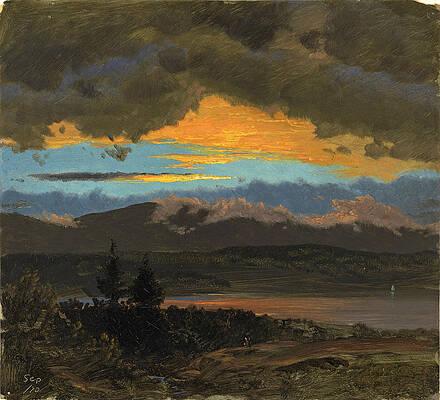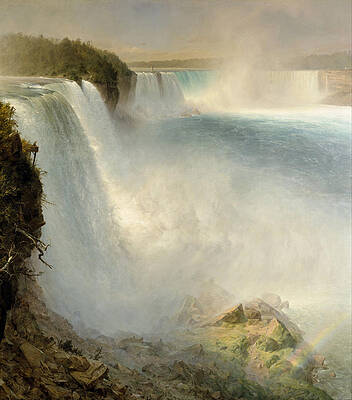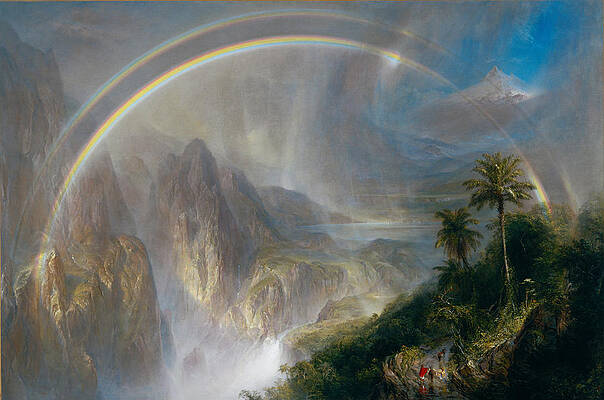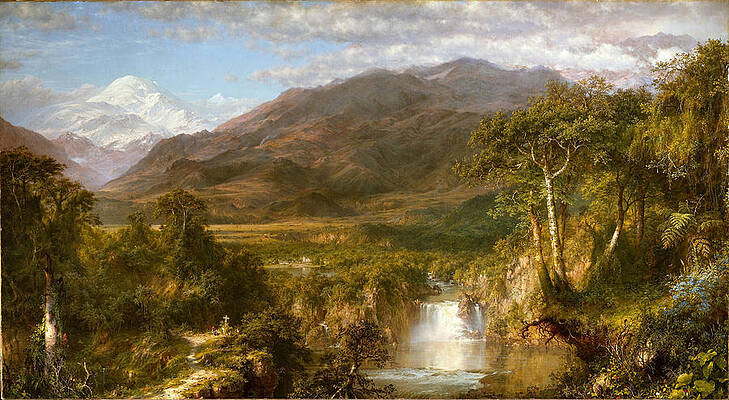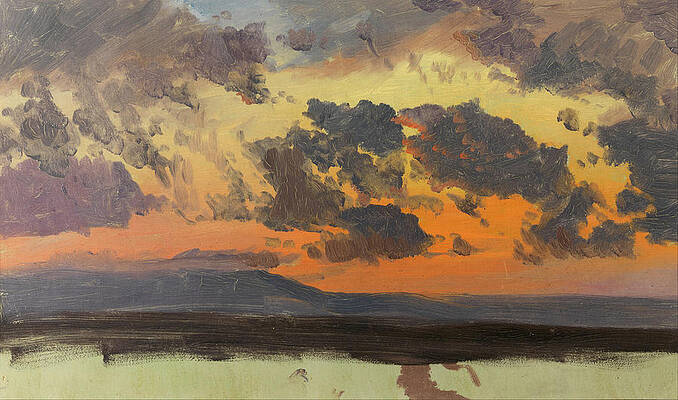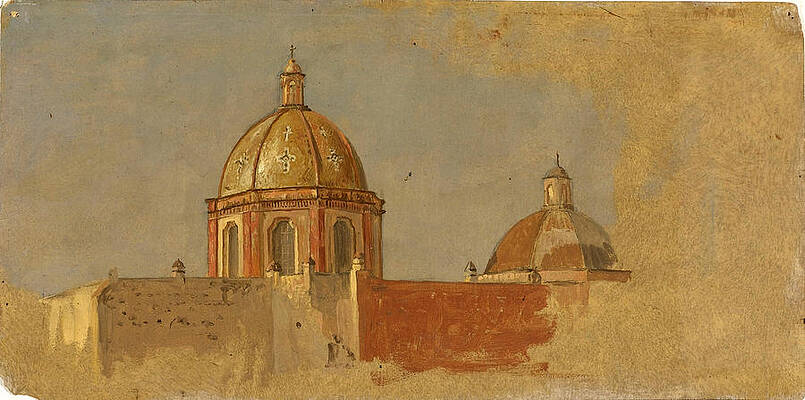Frederic Edwin Church
Paintings, Drawings
Sunset across the Hudson Valley. New York
Niagara Falls from the American Side
Autumn
Rainy Season in the Tropics
Abandoned Skiff
South American Landscape
Sunset in the Hudson Valley
Aurora Borealis
Jerusalem from the Mount of Olives
The Heart of the Andes
Sky at sunset. Jamaica. West Indies
The Parthenon
Niagara Falls
Cotopaxi
Cross in the Wilderness
Final Study for the Icebergs
View of Blackwell's Island. New York. Youle's Shot Tower East River New York. View of Hartford
Winter on the Hudson River near Catskill. New York
Tropical Scenery
Morning Looking East over the Hudson Valley from the Catskill Mountains
Colombia or Ecuador church roofs
Colombia. Baranquilla Church
Niagara Falls by Moonlight
A Waterfall in Colombia
Studies of Mount Chimborazo, Ecuador
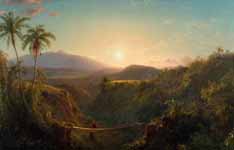
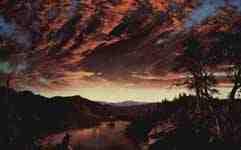






Beacon, off Mount Desert Island









El Rio de Luz (The River of Light)


Figures in an Ecuadorian Landscape








Mount Katahdin from the West (Looking West toward Mount Katahdin)

A Donkey, Baranquilla, Columbia


A Part of Penobscot County, Maine




Bamboo Bridge at Buga, Colombia and Girl Carrying a Jar, Cartago, Colombia


Botanical Sketch Showing Two Views of the Tamaca Palm

Botanical Sketches, South America

Calle de Commerce, Barranquilla, Colombia

Cathedral at Popayan, Columbia

Cayambé, Morning, from the Temple of the Sun, Quito

Cathedral at Popayan, Columbia




Colombia, Barranquilla, portrait of boy

Colombia, Barranquilla, Two Houses

Colombia or Ecuador, church roof


Cotopaxi from Guapulo, Ecuador

Cotopaxi seen from Ambato, Ecuador



Distant View of the Katahdin shown from West

a. Sketch. Tequendama Ralls near Bogota, Colombia. b. View of distant mountain ranges

Botanical sketches from Colombia

Sketches. The village Guarumo, probably in Colombia.

Sketches from Rome. A. St. Peters and the Vatican Place shown from the northeast

Eagle Lake Viewed from Cadillac Mountain, Mount Desert Island, Maine

Ecuador , mountain plateau with hut


Hospital de San Juan de Dios, Honda, Colombia


Jerusalem from the Mount of Olives

Landscape with Mount Purese, Colombia



Mount Katahdin from Lake Millinocket

Mountainous landscape between Popyan and Pasto, Colombia

Mounts Katahdin and Turner from Lake Katahdin, Maine

Mt. Desert Island, Maine Coast


Niagara Falls from the American Side

Palm Trees and Housetops, Ecuador

Popayan, Colombia; Verso- Mountain Landscape, Colombia

Portrait of Bolivian Girl- Senorita Filetta Molina Bolador del Carmen, Colombia


River through Mountain Valley with Sky and Crescent Moon

Schoodic Peninsula from Mount Desert at Sunrise

Seascape with Icecap in the Distance

Shore of Lake and Foothills of Mount Katahdin

Sincholagua, Morning, from the Temple of the Sun, Quito


Sketches from Colombia- River Craft (Champan), a Woman, Group of Trees, a House

Sketches from Colombia- Trees and Rivercraft (Champans)

Sketches from South America, probably from Colombia. Birds, Trees

Sketches from South America, probably from Colombia. Botanical sketches. A house

Sketches from South America. Botanical sketches. Flying crane

Sketches from the Rio Magdalena, Colombia. Botanical sketches. A church

Sketches of Trees, Vines and a Bank of the Rio Magdalena, Columbia

Sky at sunset, Jamaica, West Indies





Studies of Man Paddling Canoe on Millinocket River

Studies of Mount Chimborazo, Ecuador

Studies of Sailing Ships and Coastal Landscapes

Study. Landscape with Mount Puresé

Study of Mount Chimborazo, Ecuador

Study of Tequendama Falls near Bogotá, Colombia

Sunset across the Hudson Valley, New York


Tequendama Falls near Bogotá, Colombia

The Falls of the Tequendama near Bogota, New Granada






Turner Pond with Pomola Peak and Baxter Peak, Maine

View of Cotapaxi from the Hacienda San Antonio, Ecuador

View of West Point from Castle Rock

Views of Puresé Volcano, Colombia and Mt. Sincholagua, Ecuador


Wooded Hilltop, Hilly Valley, Sun




Grand Manan Island, Bay of Fundy

Haying Near New Haven, West Rock




July Sunset, Berkshire County, Massachusetts


Landscape with Flaming Volcano, South America

Moses Viewing the Promised Land


























Fine Art Prints | Greeting Cards | iPhone Cases | Tote Bags | Clothing | Lifestyle | Beach ...
Frederic Edwin Church (May 4, 1826 – April 7, 1900) was an American landscape painter[1] born in Hartford, Connecticut. He was a central figure in the Hudson River School of American landscape painters, perhaps best known for painting large panoramic landscapes, often depicting mountains, waterfalls, and sunsets, but also sometimes depicting dramatic natural phenomena that he saw during his travels to the Arctic and Central and South America. Church's paintings put an emphasis on light and a romantic respect for natural detail. In his later years, Church painted classical Mediterranean and Middle Eastern scenes and cityscapes.[2]
Biography
Beginnings
Church was the son of Eliza (née Janes) and Joseph Church. The family's wealth came from Church's father, a silversmith and watchmaker in Hartford, Connecticut. (Joseph subsequently also became an official and a director of The Aetna Life Insurance Company.) Joseph, in turn, was the son of Samuel Church, who founded the first paper mill in Lee, Massachusetts in the Berkshires. The family's wealth allowed Frederic Church to pursue his interest in art from a very early age. At eighteen years of age, Church became the pupil of Thomas Cole[3] in Catskill, New York after Daniel Wadsworth, a family neighbor and founder of the Wadsworth Athenaeum, introduced the two. In May 1849, Church was elected as the youngest Associate of the National Academy of Design and was promoted to Academician the following year. Soon after, he sold his first major work to Hartford's Wadsworth Athenaeum.
Style
Aurora Borealis, (1865), Smithsonian American Art Museum, Washington, DC.
Church was the product of the second generation of the Hudson River School and the only pupil of Thomas Cole, the school’s founder. The Hudson River School was established by the British Thomas Cole when he moved to America and started painting landscapes, mostly of mountains and other traditional American scenes.[4] Both Cole and Church were devout Protestants and the latter's beliefs played a role in his paintings especially his early canvases. [5] Cole, along with his friend Asher Durand, started this school in New York; it was the first well-acknowledged American artistic movement. The paintings were characterized by their focus on traditional American pastoral settings, especially the Catskill Mountains, and their romantic qualities. This style attempted to capture the wild realism of an unsettled America that was quickly disappearing, and the feelings of discovery and appreciation for natural beauty. His American frontier landscapes show the “ expansionist and optimistic outlook of the United States in the mid-nineteenth century.” Church did differ from Cole in the topics of his paintings: he preferred natural and often majestic scenes over Cole’s propensity towards allegory.
Tropical Scenery, (1873), Brooklyn Museum
Church, like most second generation Hudson River School painters, used extraordinary detail, romanticism, and luminism in his paintings. Romanticism was prominent in Britain and France in the early 1800s as a counter-movement to the Enlightenment virtues of order and logic. Artists of the Romantic period often depicted nature in idealized scenes that depicted the richness and beauty of nature, sometimes also with emphasis on the grand scale of nature.
El Río de Luz (The River of Light, (1877), National Gallery of Art
This tradition carries on in the works of Frederic Church, who idealizes an uninterrupted nature, highlighted by creating excruciatingly detailed art. The emphasis on nature is encouraged by the low horizontal lines, and preponderance of sky to enhance the wilderness; humanity, if it is represented, is depicted as small in comparison with the greater natural reality. The technical skill comes in the form of luminism, a Hudson River School innovation particularly present in Church’s works. Luminism is also cited as encompassing several technical aspects, which can be seen in Church’s works. One example is the attempt to “hide brushstrokes,” which makes the scene seem more realistic and lessen the artist’s presence in the work. Most importantly is the emphasis on light (hence luminism) in these scenes. The several sources of light create contrast in the pictures that highlights the beauty and detailed imagery in the painting.'
Career
This article needs additional citations for verification. Please help improve this article by adding citations to reliable sources. Unsourced material may be challenged and removed. (August 2014)
Cotopaxi, 1855
Church began his career by painting classic Hudson River School scenes of New York and New England, but by 1850, he had settled in New York. Church’s method consisted of creating paintings in his studio (in the cold, barren months of the year) based on sketches (some in oil) created of views in the summer months. In these earlier years of his career, Church’s style was reminiscent of that of his teacher, Thomas Cole, and epitomized the Hudson River School’s founding styles. Church’s work was immediately divergent from Cole’s focus on ethereal, almost mythological, scenes, but his early work did resemble Cole’s tone. Church focused on scenes composed of rich reds, purples, and oranges to give depth to his work and emphasize the richness and fantasy of the scenery.
Heart of the Andes (1859), Metropolitan Museum of Art
Church took two trips to South America, and stayed predominantly in Quito, Ecuador, the first in 1853 and the second in 1857. One trip was financed by businessman Cyrus West Field, who wished to use Church's paintings to lure investors to his South American ventures. Church was inspired by the Prussian polymath geographer Alexander von Humboldt's Cosmos (about “the Earth, matter, and space”) and his exploration of the continent in the early 1800s; Humboldt had challenged artists to portray the "physiognomy" of the Andes. After Humboldt’s Personal Narrative of Travels to the Equinoctial Regions of America was published in 1852, Church jumped at the chance to travel and study in his icon’s footsteps (literally, as he stayed in Humboldt’s old house) in Quito, Ecuador. When Church returned in 1857 he added to his landscape paintings of the area. After both trips, Church had produced four landscapes of Ecuador:The Andes of Ecuador (1855), Cayambe (1858), The Heart of the Andes (1859), and Cotopaxi (1862). It was the Heart of the Andes that won Church fame when it debuted in 1859. The painting pictures several elements of Quito’s nature combined into an idealistic portrait of a jungle scene. Despite having clear perspective and foreshortening, Church keeps every detail (even those of the mountains in the back) in crystal clear detail. In addition, The Heart of The Andes is also a documentation, a scientific study of every natural feature that exists in that area of the Andes. Every species of plant and animal is readily identifiable; even climatic zonation by altitude is delineated precisely.
Cotopaxi, (1862)
In this way, Church pays a unique tribute to Humboldt (who inspired his journey) as well as maintains his Hudson River School roots. “Therefore instead of the fiery crimsons and oranges of his emotional crepuscular scenes, the palette here is comparatively restrained by Church's standards: quiet greens, blues, browns, ochres and subdued grayish purples of sky, stone, verdure and water in full, even daylight.”[6] It was in 1859 that Church finally showed The Heart of the Andes in New York City. Church had set up the exhibit like a house, with the painting playing the part of a window looking out over the Andes. He completed the look with Ecuadorian plants from his travels and a frame and curtains which the audience (sitting on benches) looked through to enhance the effect. Church unveiled the painting to an astonished public in New York City in 1859. The painting's frame had drawn curtains fitted to it, creating the illusion of a view out of a window. The audience sat on benches to view the piece and Church strategically darkened the room, but spotlighted the landscape painting. Church also brought plants from a past trip to South America to heighten the viewers' experience. The public were charged admission and provided with opera glasses to examine the painting's details. The work was an instant success. Church eventually sold it for $10,000, at that time the highest price ever paid for a work by a living American artist. During the Civil War, Church was inspired to paint "Our Banner in the Sky", from which a lithograph was made and sold to benefit the families of Union soldiers. [7]
The Metropolitan Museum of Art in New York City exhibited The Heart of the Andes in its original frame in 1995-96, together with a number of the supporting studies that Church made on his epic Andean journey. Americans soon began to consider Church the “Michelangelo of Landscape Art” and he became one of the most renowned American artists. Part of Church’s appeal was the fact that he had resisted the American artist “norm” of the day by refusing to go to Europe, as most artists did to train, instead focusing his efforts and talents on South America. This was in part due to Humboldt's influence, but was also a conscious decision on Church’s part to gain notoriety. In addition, one of Church’s most extraordinary accomplishments was his commercial success. Church’s art was extremely lucrative, he was reported to be worth approximately half-a-million dollars at his death, about 12.5 million dollars today. Americans were enamored with Church’s all-American appeal and brilliant body of work. Church exhibited his art at the American Art Union, the Boston Art Club, and (most impressively for a young artist) the National Academy of Design. He joined his contemporaries in the Hudson River School: Thomas Cole, Asher Brown Durand, John F. Kensett, and Jasper F. Cropsey.
Family
Mansion at Olana, 2006
In 1860, Church bought a farm in Hudson, New York and married Isabel Carnes. Both Church's first son and daughter died in March 1865 of diphtheria, but he and his wife started a new family with the birth of Frederic Joseph in 1866. When he and his wife had a family of four children, they began to travel together. In 1867, they visited Europe and the Middle East, allowing Church to return to painting larger works.[8]
Before leaving on that trip, Church purchased the eighteen acres (73,000 m²) on the hilltop above his Hudson farmland he had long wanted because of its magnificent views of the Hudson River and the Catskills. In 1870, he began the construction of a Persian-inspired mansion on the hilltop and the family moved into the home in the summer of 1872. Richard Morris Hunt was the architect for Cosy Cottage at Olana,[3] and was consulted early on in the plans for the mansion, but after the Churches' trip to Europe and what is now Lebanon, Israel, Palestine, Syria, Jordan, and Egypt, the English architect Calvert Vaux was hired to complete the project.[3] Church was deeply involved in the process, even completing his own architectural sketches for its design. This highly personal and eclectic castle incorporated many of the design ideas that he had acquired during his travels.
View of the Hudson from the mansion
Illness affected Church's output. Although he was enormously successful as an artist, by 1876, Church was stricken with rheumatoid arthritis which greatly reduced his ability to paint. He eventually painted with his left hand and continued to produce his work, although at a much slower pace. He devoted much of his energies during the final 20 years of his life to his house at Olana.
Death
Church died on April 7, 1900 at his home. He is buried in Spring Grove Cemetery, Hartford, Connecticut.
Legacy
Olana State Historic Site is now owned and operated by the New York State Office of Parks, Recreation and Historic Preservation, Taconic Region and receives extensive support from The Olana Partnership, a private, non-profit organization.
Works
Main article: List of works by Frederic Edwin Church
Among Church's paintings are:
Home by the Lake (1852), Amon Carter Museum. The painting, termed "a testament to the country's pioneer spirit," features a husband hunting for game and a wife carrying water that she had drawn from a well on their farm, which is built by hard labor in the wilderness.[9]
The Falls of Tequendama (1854), Cincinnati Art Museum
The Andes of Ecuador (ca. 1854), Reynolda House Museum of American Art
Niagara (1857), Corcoran Gallery of Art view
The Heart of the Andes (1859), Metropolitan Museum of Art
Twilight in the Wilderness (1860), Cleveland Museum of Art
The Icebergs (1861), Dallas Museum of Art
Cotopaxi (1862), Detroit Institute of Arts
Aurora Borealis (1865), Smithsonian American Art Museum
Niagara Falls from the American side (1867), National Gallery of Scotland
View of Wimmis, Valley of the Simmental, Switzerland (1868), Fogg Museum
Syria by the Sea (1873), Detroit Institute of Arts
The River Of Light (1877), National Gallery of Art view
The Parthenon in Athens (1871), Metropolitan Museum of Art
Mediterranean Sea (1882), Olana State Historic Site
Sunset from Olana (1891), Fogg Museum
See also
Portal icon Hudson Valley portal
Portal icon Visual arts portal
List of Hudson River School artists
References
Franklin Kelley, Stephen Jay Gould, James Anthony Ryan, Debora Rindge (1989), Frederic Edwin Church, Smithsonian Institution Press, Washington and London, pp. 1–211
"Voyage of the Icebergs -online book". /issuu.com/dallasmuseumofart. Retrieved 2014.
"Frederic Edwin Church". Collection. Cooper-Hewitt, National Design Museum. Retrieved 30 September 2012.
"Master, Mentor, Master: Thomas Cole & Frederic Church". http://www.thomascole.org. Retrieved September 2014. External link in |publisher= (help)
Updike, John (2012). Always Looking: Essays on Art.
Scherer, Barrymore Laurence. "South American Sublimity". The Wall Street Journal.
https://m.facebook.com/note.php?note_id=10151215572059000
"Explore Church's World". www.olana.org. Retrieved September 2014.
Exhibit at the Amon Carter Museum in Fort Worth, Texas
Further reading
Adelson, Warren; Hankin, Lisa Bush; Carr, Gerald L. (2008). Frederic Edwin Church: Romantic Landscapes and Seascapes. New York: Adelson, Altman, Long. ISBN 978-0-9741621-7-1.
Avery, Kevin J. (1993). Church's great picture, The heart of the Andes. New York: The Metropolitan Museum of Art. ISBN 9789994925193.
----
Fine Art Prints | Greeting Cards | Phone Cases | Lifestyle | Face Masks | Men's , Women' Apparel | Home Decor | jigsaw puzzles | Notebooks | Tapestries | ...
----
Artist
A - B - C - D - E - F - G - H - I - J - K - L - M -
N - O - P - Q - R - S - T - U - V - W - X - Y - Z
Retrieved from "http://en.wikipedia.org/"
All text is available under the terms of the GNU Free Documentation License


